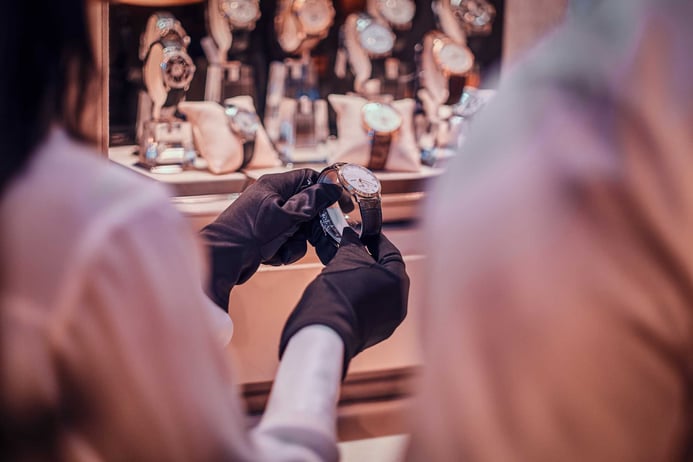Today, affluent consumers place a significant value on experiences instead of possessions and seek brands that represent a particular lifestyle. Customer experience is arguably more crucial than the product's price and even the product itself. Luxury brand shopping extends beyond just a transactional purchase, it's now an emotional investment, and shoppers expect a premium, superior and luxurious experience.
As a result, successful brands choose to invest heavily in glamorous shops in great, fashionable locations, elegant billboard ads, a stylish social presence, and attentive sales reps.
Customer experience, especially when it comes to luxury brands, offers benefits to both the customer as well as the brand. Shoppers want to feel valued and special from the time they hear and become aware of the product to all other times they interact with it again. Brands interact with shoppers throughout their buying journey to get insights such as priorities, preferences, and customer lifestyle and thus help determine the best fit as well as a personalized product.
However, many luxury brands get the sales experience right, but when the excitement of a particular purchase wanes, the after-sales customer support becomes lackluster.
To ensure luxury customers feel valued, luxury brands must first understand their market: luxury shoppers are more tech-savvy and younger and rely more strongly on digital channels than ever. Today, they typically have a mixture of offline and online interactions with the firm, seek advice and recommendations from peers, or seek suggestions from reliable bloggers before visiting a store.
So how can luxury brands leverage these channels to build an exceptional customer experience?
The luxury watch industry
The wristwatch concept emerged during World War I as soldiers originally used them as a practical and convenient way to keep time. Since then, this historical device has achieved a ubiquitous status, gradually morphing into a lavish and stylish accessory revered not just for its ability to tell time but also for its craftsmanship and masterful design.
Luxury watches are premium-priced, high-quality accessories produced by skilled craftsmen. The industry manufactures high-end products using precious elements such as silver, gold, ruby, diamond, and sapphire, all of which act as a great opportunity that drives the growth of the market. Some propelling factors that boost sales of these products include the material use, pricing strategy, and the product's prestige. A luxury brand has a great pricing strategy than other watch brands as it is a high-end product. And since they are expensive, exclusive, and not mass-produced, luxury watches can easily be differentiated from their regular counterparts because of their uniqueness and durability. Today, inflating disposable incomes and enhancing living standards drive the increasing demand for luxury watches worldwide.
However, a few years ago, the once-honored luxury watch market experienced a significant decline in popularity and sales. In 2017, the luxury watch industry was at its weakest point since the early 80s. The collapse of many key global markets and the rise of the smartwatch meant that the proud timepiece industry was in trouble. They had to change tactics to encourage customers to fall back in love with the brand.
The luxury watch industry performance & outlook
The global market for luxury watches reached $27.19 billion in 2021. Looking forward, the luxury watch market is projected to record $28.43 billion at a compound annual growth rate (CAGR) of 4.6% in 2022 and is expected to grow to $33.07 billion by 2027 at a CAGR of 3.9%.
The rising consumer preference worldwide for premium, high-quality watches perceived as a symbol of status is expected to propel the industry growth of the luxury watches market. Customers want to use high-quality products with highly advanced technologies, methods, and materials. The surge in the luxury watches trend is driven by customers' preference for high-end products. And the use of accessories to enhance one's looks is a popular fashion trend. This contributes to the increasing growth of the luxury watch market.
Furthermore, the availability of luxury watches in dial colors, unique materials, themes, and strap designs contributes to the market growth. Plus, several market players now offer secondhand luxury products at discounted prices through ecommerce stores. This, together with the growing popularity of pre-owned luxury products, especially among young shoppers, on account of their accessibility and affordability, is compelling the growth of the market.
The global pandemic also provoked an increasing concentration and luxury items, including timepieces, are now heavy investment pieces during uncertain times.
The luxury watch industry challenges and opportunities
Over the years, the luxury watch industry has grown to be one of the largest watch manufacturing industries in the world, beating its counterparts. While not the brains supporting the innovation of watches, the luxury brand boomed and became known for producing sophisticated, luxurious, and quality watches guaranteeing excellence.
In years past and recent times, however, the industry has experienced challenges that have caused a decline in production, sales, and exports and, as a result, led to growth, transformation, and revitalization of the industry.
Since its inception, the luxury watch industry has often had to deal with technological advancement and innovation challenges since most watch manufacturers are mechanical and traditional. This makes smartwatches a threat. However, traditional brands are advancing as well, and customers increasingly prefer to own both. Besides, smartwatches have functions different from traditional timepieces, and several brands operating in superior price segments don't consider pieces like Samsung and Apple to be competitors.
The industry has also been facing another technological challenge, smartphones. The introduction and development of smartphones have seen a decline in sales volume as well as exports in the luxury watch industry. The 2021 Deloitte study found that the demand for smartphones doubled since 2018, with Apple being the market dominant.
However, traditional brands are responding with their own adaptations to technological issues. For instance, traditional watch manufacturers can utilize their expertise to benefit from the growing interest in wearables by producing connected watches with longer battery life and better movements.
A decline in production volumes, lack of authenticity, decreased expertise, and how to react to changing consumer attitudes also trouble industry leaders. The pandemic demonstrated the danger of being complacent, and while the timelessness and heritage of traditional watchmaking are often undisputed, it's clear that past success doesn't define future prospects. The industry needs to work together to preserve the skills and craftsmanship of traditional watchmaking, stand up to international competition and maintain Swiss quality.
Another highlighted challenge is the lack of brand identity and positioning. Consumers now look for brands that they identify with more or whose messaging resonates with them. Therefore a brand trying to satisfy everyone's needs will struggle to differentiate. While luxury brands can boast of their craftsmanship and quality, their personality or story is what makes them stand out.
In addition, the pandemic brought everything to a standstill affecting the global economy, including the luxury watch industry. The pandemic caused various issues, the most prominent being the supply chain disruption which led to a shortage of manufacturing machinery and materials. The lockdown also affected several companies' work schedules, leading to declining production volumes.
What does today's luxury watch consumer look like?
Consumer behaviors and attitudes are constantly changing, and many brands fear they fail to understand what consumers want to possibly anticipate their preferences and adapt to their needs and expectations. The primary concern is whether customers will still wear traditional watches for years to come. Other significant worries include how to communicate with them in the current digital world and how to adequately introduce the market to a brand using digital mediums. Moreover, the very definition of luxury and its evolving nature keeps leaders awake at night.
Millennials and Gen Zs now consider owning a watch as a critical accessory, no longer a necessity for timekeeping. However, that doesn't mean that it's falling out of fashion. Luxury watch brands are still a symbol of status for many people.
"Forty percent of people buy only one watch in their lifetime; it is, therefore, vital to be in the right place at the right time when it comes to marketing activities. Podcasts, Youtube, and Instagram, are the preferred digital channels to drive interaction and visibility in our main markets." Brian Duffy, CEO, Watches of Switzerland.
During uncertain economic times and volatile stock markets, timepieces, jewelry, and other tangible assets are relatively safe strategies to diversify an individual's portfolio.
Today, brand image, design, and value ratio are the top deciding factors for consumers when buying a luxury watch, and brand ambassadors, social media, and influencers play an integral role.
Brands must now be both consistent and unique in conveying their messaging across all channels to differentiate themselves in such a saturated and fast-paced market. Many luxury watch brands can draw on their meticulous craftsmanship, long heritage, or both.
Luxury brands need to be inclusive and approachable to meet the digital needs of young shoppers in the internet era. They also need to include shoppertainment, a mix of entertainment and shopping, to treat shopping as beyond just an act of purchasing a product. Include digital tools like augmented reality, gamification, and live streaming.
How to tailor the experience to the new luxury watch consumer?
Luxury brands need to rethink their marketing strategies to reach modern-day consumers. Here are luxury marketing approaches for service excellence, exceptional customer experience, and sustainable sales.
Differentiation
The key differentiator for luxury watches is that most of them are sold in a multi-brand environment with heritage and craftsmanship. When every brand sells craftsmanship and heritage, from the customer's perspective, there's no differentiation.
Move from transaction to experience.
The traditional sales model focuses on making a transaction, making most brands unable to develop long-term relationships with consumers apart from a few occasional newsletters. Build a platform and constantly engage consumers offering a fully integrated physical and digital retail experience that is inspiring and engaging.
Embrace digitalization
Digital augmentation of customer experiences can delight consumers and distinguish brands. Out of necessity, retailers and brands have shifted their operations to online platforms, with some expanding their existing channels and others building new ecommerce platforms.
Phygital Events
During the pandemic, the luxury industry needed to swiftly up its digital game to survive. By hosting live discussions on social platforms, brands merged the physical with the online to create an impactful momentum.
Sustainability
Sustainability is increasingly becoming a critical topic among consumers that luxury watch brands need to consider in their plans. New retailing approaches, different business models, and approachability will help luxury brands expand to new, larger audiences.
Conclusion: CX is king in the luxury watch market
The luxury watch industry combines timeless design and high-end craftsmanship into a desirable product that stays with consumers for decades. And manufacturing advancement and factory-direct retail models have opened luxury brands to new markets.
But to achieve exceptional customer experience in the luxury watch industry, brands must find new, innovative ways to connect with customers in digitally enhanced interactions and reduce costs without compromising on quality and design.





